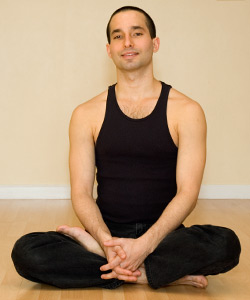Adam Dobbs said he put an end to his substance addiction by sheer will power alone.
Dobbs, who struggled with depression and drug addiction as a teen, said he didn’t take to conventional treatments like therapy and medication.
“Here I am dependent on substances so now I’m just transferring my dependance over to legal substances in order to achieve a balanced state,” said Dobbs, now 40 and living in Williston Park. “And I just didn’t really agree with it.”
Instead, Dobbs chose to embrace meditation to heal.
He started his practice at 16, and said by 19 he put an end to his substance abuse.
Years later, he also used a therapeutic yoga to treat himself after a fall that resulted in a serious injury.
He said he resisted the doctor’s suggestion to have surgery and instead found Ashtanga yoga, which helped cure his injuries.
Dobbs incorporates Ashtanga into classes he now teaches.
Dobbs teaches yoga at several studios, including Sumadra Yoga in Garden City, Absolute Yoga in Woodbury, Sukha Yoga in Cold Spring Harbor and Ashtanga Yoga Long Island in Seaford.
He also teaches private yoga classes and has a license in massage therapy.
Dobbs started teaching at 20, a career he chose after a six-month stay at the Kiraplu Center for Yoga and Health.
Dobb’s experience at the Kiraplu Center opened up his world, he said.
“There was a certain sort of mainstream way of thought living on Long Island,” Dobbs said. “Everybody kind of thought a certain way or saw life in a certain way and when I went there, there were people from all over who came to visit or live there …. it was so enriching to see that there are so many ways to live a life.”
Dobb said he was saturated by the healthy lifestyle and habits that he was surrounded by at the center.
From that point he knew he wanted to become an instructor, he said.
“I would go into the room as a student in yoga classes and think, ‘This is something I can do, this is becoming such a party of me and I want to share it with others,'” Dobb said.
Since the late 90s when Dobb started his yoga and mediation journey, the practice has become more common, he said.
Dobb himself sits for an hour every day, he said.
However, he said, that much time isn’t necessary to feel the benefits.
“If you can sit 20 minutes, there’s so much power in that,” Dobb said.
He recommends people start by committing to just five minutes a day and slowly adding on a minute or so every week until there’s a 20 minute daily practice.
Dobb also recommends people experiment with different types of mediation practices and styles.
He said he’s found through working with students over the years many people feel they are incapable of meditating, but just like with any other activity it takes practice.
“They have this notion in their mind, ‘I can’t meditate my mind is too busy,'” Dobb said. “It’s like people saying, ‘I can’t do yoga because I’m not flexible.’ When we know one of the reasons to practice yoga is because you will become more flexible through practice.”
The same is true with meditation – the more you do it the more you’ll be able to “drop in and observe your own mind,” he said.
Since meditating, Dobb said, he has more clarity and control over his actions.
“Everybody’s human, I have my moments,” Dobb said. “But for the most part I feel very even and able to float through my day without much fluctuation in my moods … that’s a big deal, just to feel calm and steady and float through life with harmony.”



